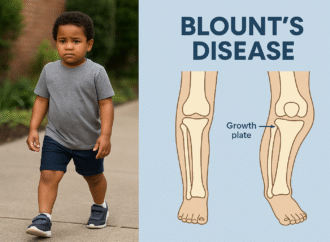Biceps Tendon Rupture
- Symptoms & Conditions
- February 25, 2017

Physical Therapist’s Guide to Calf Strain A calf strain is an injury to the muscles in the calf area (the back of the lower leg below the knee). The calf muscle is actually composed of up to 9 separate muscles, any of which can be injured individually or together. Calf strains can occur during hi-speed
READ MOREPhysical Therapist’s Guide to Bunion (Hallux Valgus) A bunion (hallux valgus) is a large bump on the side of the foot that develops at the base of the big toe. It is common for a bunion to become inflamed and swollen, causing foot pain. Although anyone can develop a bunion, the condition most often occurs
READ MORE
Physical Therapist’s Guide to Blount’s Disease Blount’s disease is a growth disorder affecting the shin bone, also called the tibia, and is characterized by the lower leg turning inward, causing the leg to appear bowed below the knee. Blount’s disease can affect toddlers, children, and adolescents. Although the exact cause of the condition is unknown,
READ MOREPhysical Therapist’s Guide to Biceps Tendon Rupture A biceps tendon rupture occurs when the biceps muscle is torn from the bone at the point of attachment (tendon) to the shoulder or elbow. Most commonly, the biceps tendon is torn at the shoulder. These tears occur in men more than women; most injuries occur at 40
READ MOREPhysical Therapist’s Guide to Biceps Tendinitis Biceps tendinitis is a common cause of shoulder pain, often developing in people who perform repetitive, overhead movements. Biceps tendinitis develops over time, with pain located at the front of the shoulder, and usually worsens with continued activity. When treating biceps tendinitis, physical therapists work to determine the exact
READ MOREPhysical Therapist’s Guide to Benign Paroxysmal Positional Vertigo (BPPV) Every year, millions of people in the United States develop vertigo, a sensation that you or your surroundings are spinning.The sensation can be very disturbing and may increase the risk of falling. If you’ve been diagnosed with benign paroxysmal positional vertigo (BPPV), you’re not alone—at least
READ MORE
